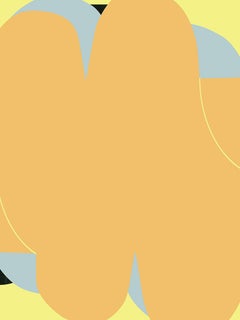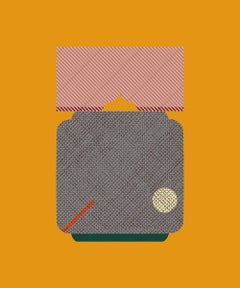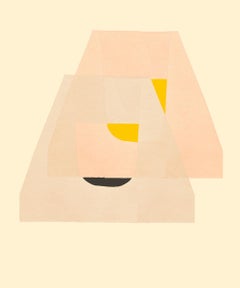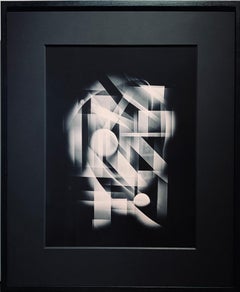Alyson Fox Prints and Multiples
American
Alyson Fox is a whimsical and vibrant artist whose works tap into many colors and shapes. Defying easy categorization, Alyson Fox is a critically acclaimed artist who enlivens space with a vibrant spirit. Expertly activating her forms and media with a playfully poetic essence, Fox’s work is captivatingly exuberant. She loves to work across multiple mediums, and is always looking for new collaborations since she enjoys designing for commercial ends or no ends at all!(Biography provided by ArtStar)
to
5
5
5
Overall Height
to
Overall Width
to
5
5
985
777
651
624
5
5
Artist: Alyson Fox
Cucumber Sandwich
By Alyson Fox
Located in New York, NY
ABOUT THIS PIECE: With lively colors and jubilant forms, Alyson Fox's work is as playful as her approach to work and life. With a contagious energy, Fox's work brightens space as muc...
Category
2010s Alyson Fox Prints and Multiples
Materials
Photographic Paper
Sardine Sandwich
By Alyson Fox
Located in New York, NY
ABOUT THIS PIECE: With lively colors and jubilant forms, Alyson Fox's work is as playful as her approach to work and life. With a contagious energy, Fox's work brightens space as muc...
Category
2010s Alyson Fox Prints and Multiples
Materials
Photographic Paper
Grandma's Lamp
By Alyson Fox
Located in New York, NY
ABOUT THIS PIECE: With lively colors and jubilant forms, Alyson Fox's work is as playful as her approach to work and life. With a contagious energy, Fox's work brightens space as muc...
Category
2010s Alyson Fox Prints and Multiples
Materials
Photographic Paper
Dance Study 2
By Alyson Fox
Located in New York, NY
ABOUT THIS PIECE: With lively colors and jubilant forms, Alyson Fox's work is as playful as her approach to work and life. With a contagious energy, Fox's work brightens space as muc...
Category
2010s Alyson Fox Prints and Multiples
Materials
Photographic Paper
Dance Study 1
By Alyson Fox
Located in New York, NY
ABOUT THIS PIECE: With lively colors and jubilant forms, Alyson Fox's work is as playful as her approach to work and life. With a contagious energy, Fox's work brightens space as muc...
Category
2010s Alyson Fox Prints and Multiples
Materials
Photographic Paper
Related Items
Abstract Black and White Luminogram Print of Central Park in New York City
Located in London, GB
Central Park is part of a group of prints based on a visit to New York City, Because I live and work in quiet isolation and often don't meet anyone apa...
Category
2010s Abstract Geometric Alyson Fox Prints and Multiples
Materials
Photogram, Silver Gelatin, Archival Paper, Black and White, Photographic...
H 22.84 in W 18.71 in D 1.58 in
Inside Jupiter's Eye, Marbling Shapes in Warm Earth Tones Diptych, Giclée Print
By Ryan Rivadeneyra
Located in Barcelona, ES
Cyd Fontaine (Lausanne, 1992) is a contemporary artist renowned for her captivating use of dreamy atmospheric gradients, which has helped her carve a distinctive niche in the world o...
Category
2010s Contemporary Alyson Fox Prints and Multiples
Materials
Photographic Film, Archival Ink, Photographic Paper, C Print, Digital, G...
Thomas Demand, Grotto (from Catalogue Serpentine Gallery): 2 Photographs, Signed
By Thomas Demand
Located in Hamburg, DE
Thomas Demand (German, born 1964)
Grotto (from Catalogue Serpentine Gallery, Collector’s Edition), 2006/2009
Medium: Set of 2 cibachrome prints, exhibition catalogue
Dimensions: each...
Category
21st Century and Contemporary Contemporary Alyson Fox Prints and Multiples
Materials
Photographic Paper
Forest Embers, Giclée Print Diptych Landscape, Warm Tons Abstract Autumn Leaves
By Ryan Rivadeneyra
Located in Barcelona, ES
Cyd Fontaine (Lausanne, 1992) is a contemporary artist renowned for her captivating use of dreamy atmospheric gradients, which has helped her carve a distinctive niche in the world o...
Category
2010s Abstract Impressionist Alyson Fox Prints and Multiples
Materials
Photographic Film, Archival Ink, Photographic Paper, C Print, Digital, G...
Free Shipping
H 36 in W 48 in
Vintage Abstract Expressionist Hyman Bloom Photo Collage Assemblage Photograph
By Martin Sumers
Located in Surfside, FL
This is a unique original collage, decoupage style of Jiri Kolar, This is an exceptional artwork which was part of a collaboration between Hyman Bloom and fellow artist and his very good friend Martin Sumers. This is pencil signed by Martin Sumers.
Provenance: Acquired from the Sumers estate collection.
Hyman Bloom (March 29, 1913 – August 26, 2009) was a Latvian-born American painter. His work was influenced by his Jewish heritage and Eastern religions as well as by artists including Altdorfer, Grünewald, Caravaggio, Rembrandt, Blake, Bresdin, James Ensor and Chaim Soutine. He first came to prominence when his work was included in the 1942 Museum of Modern Art exhibition "Americans 1942 -- 18 Artists from 9 States". MoMA purchased 2 paintings from the exhibition and Time magazine singled him out as a "striking discovery" in their exhibition review.
His work was selected for both the 1948 and 1950 Venice Biennale exhibitions and his 1954 retrospective traveled from Boston's Institute of Contemporary Art to the Albright Gallery and the de Young Museum before closing out at The Whitney Museum of American Art in 1955. In a 1954 interview with Yale art professor Bernard Chaet, Willem de Kooning indicated that he and Jackson Pollock both considered Bloom to be “America’s first abstract expressionist”, a label that Bloom would disavow. Starting in the mid 1950s his work began to shift more towards works on paper and he exclusively focused on drawing throughout the 1960s, returning to painting in 1971. He continued both drawing and painting until his death in 2009 at the age of 9
Hyman Bloom (né Melamed) was born into an orthodox Jewish family in the tiny Jewish village of Brunavišķi in what is now Latvia, then part of the Russian Empire
At a young age Bloom planned to become a rabbi, but his family could not find a suitable teacher. In the eighth grade he received a scholarship to a program for gifted high school students at the Museum of Fine Arts. He attended the Boston High School of Commerce, which was near the museum. He also took art classes at the West End Community Center, a settlement house. The classes were taught by Harold Zimmerman, a student at the School of the Museum of Fine Arts, who also taught the young Jack Levine at another settlement house in Roxbury. When Bloom was fifteen, he and Levine began studying with a well-known Harvard art professor, Denman Ross, who rented a studio for the purpose and paid the boys a weekly stipend to enable them to continue their studies rather than take jobs to support their families.
He took Bloom and Levine on a field trip to the Museum of Modern Art in New York, where Bloom was impressed by the work of Rouault and Soutine and began experimenting with their expressive painting styles.
In the 1930s Bloom worked sporadically for the Public Works of Art Project and the Federal Art Project (WPA), He shared a studio in the South End with Levine and another artist, Betty Chase. It was during this period that he developed a lifelong interest in Eastern philosophy and music, and in Theosophy.
He first received national attention in 1942 when thirteen of his paintings were included in the Museum of Modern Art (MoMA) exhibition Americans 1942: 18 Artists from 9 States, curated by Dorothy Miller. MoMA purchased two of his paintings from that exhibition, and he was featured in Time magazine. The titles of his paintings in the exhibition reflect some of his recurring themes. Two were titled The Synagogue, another, Jew with the Torah; Bloom was actually criticized by one reviewer for including "stereotypical" Jewish images. He also had two paintings titled The Christmas Tree, and another titled The Chandelier, both subjects he returned to repeatedly. Another, Skeleton (c. 1936), was followed by a series of cadaver paintings in the forties, and The Fish (c. 1936) was one of many paintings and drawings of fish he created over the course of his career.
Bloom was associated at first with the growing Abstract Expressionist movement. Willem de Kooning and Jackson Pollock, who first saw Bloom's work at the MoMA exhibition, considered Bloom "the first Abstract Expressionist artist in America." In 1950 he was chosen, along with the likes of de Kooning, Pollock, and Arshile Gorky, to represent the United States at the Venice Biennale. That same year Elaine de Kooning wrote about Bloom in ARTnews, noting that in paintings such as The Harpies, his work approached total abstraction: "the whole impact is carried in the boiling action of the pigment". In 1951 Thomas B. Hess reproduced Bloom's Archaeological Treasure in his first book, Abstract Painting: Background and American Phase, along with works by Picasso, Pollock, and others. Both de Kooning and Hess remarked on Bloom's expressive paint handling, a key characteristic of Abstract Expressionist painting.
As abstract expressionism dominated the American art world, Bloom became disenchanted with it, calling it "emotional catharsis, with no intellectual basis." In addition, instead of moving to New York to pursue his career, he opted to stay in Boston. As a result he fell out of favor with critics and never achieved the kind of fame that Pollock and others did. He disliked self-promotion and never placed much value on critical acclaim.
Many of Bloom's paintings feature rabbis, usually holding the Torah. According to Bloom, his intentions were more artistic than religious. He began questioning his Jewish faith early in life, and painted rabbis, he claimed, because that was what he knew. Over the course of his career he produced dozens of paintings of rabbis...
Category
20th Century Modern Alyson Fox Prints and Multiples
Materials
Paper, Photographic Paper
In Between the Shadows
Located in London, GB
The series ‘In Between the Shadows’ consists of structural and geometric photographs that take their inspiration from the cubist movement.
The works aim to challenge the conventional perception of depth within the medium of photography by showing different viewpoints at the same time and within the same space. The chiaroscuro lighting embraces shadows and light as juxta- positional tools to deconstruct familiar objects and transform them into surreal compositions.
Sander Vos...
Category
2010s Cubist Alyson Fox Prints and Multiples
Materials
Photographic Paper, Black and White, Archival Pigment
UNDER THE SKIN 3 signed #20/20 by Paula Craioveanu Surreal Nude Photography
By Paula Craioveanu
Located in Forest Hills, NY
Under the Skin #3
Surreal Nude, part of my "Under the Skin" series.
Printed on Hahnemuhle art photo paper with white borders, size is 12.5x12.5in.
This particular one is signed and...
Category
2010s Surrealist Alyson Fox Prints and Multiples
Materials
Photographic Paper
Under the Volcano, Mauve and Yellow, Earth Tones Diptych, Space Shapes, Mountain
By Ryan Rivadeneyra
Located in Barcelona, ES
Cyd Fontaine (Lausanne, 1992) is a contemporary artist renowned for her captivating use of dreamy atmospheric gradients, which has helped her carve a distinctive niche in the world o...
Category
2010s Contemporary Alyson Fox Prints and Multiples
Materials
Photographic Film, Archival Ink, Photographic Paper, C Print, Digital, G...
Free Shipping
H 36 in W 48 in
ATO>MIC #13, Unique Silver Luminogram Print, Two spheres and triangle with shade
Located in London, GB
ATO>MIC #13, 2020
Unique Gelatin Silver Print/ Luminogram and Photogram technique, Printed on tea infused fibre based paper, Framed: custom made frame with anti-reflective art glass
Print size: 23 x 18 cm
Framed: 38 x 35.5 cm
Unique
Series: ATO>MIC
Signed and dated in pencil on print's verso
Certificate of Authenticity provided
The 3D concepts that were first expanded in the same art movement by El Lissitzky a hundred years ago, are also explored here by Jackson’s drowned thin line within the third of the image. In his vision, the line reflects a shelf with the object on top, by adding the weight to it, the gravity pushing them down.
"At first glance the viewer may only see geometric spherical shapes with added lines and rectangles on tea toned Silver Gelatin paper. "The supremacy of pure artistic feeling" rather than the visual depiction of objects assign to the art movement of Suprematism comes to one's mind. Similarly, like a giant of abstract art Kasimir Malevich, Jackson wants the viewer to look further, deeper than one might usually.
The feeling of 'sensation' of the ATO>MIC prints, the sharpness of the forms, the intensity defying its size to condensed 9 x 7 inches' paper, make it all the more dramatic to look at. It takes the viewer to another level of fantastical world of creation."
About the Artist:
Michael G Jackson...
Category
2010s Suprematist Alyson Fox Prints and Multiples
Materials
Color, Photogram, Photographic Paper, Silver Gelatin, Black and White, A...
H 14.97 in W 13.98 in D 1.19 in
Under the Skin 5 signed #2/20 Paula Craioveanu Photograph 20x16in in mat 28x20in
By Paula Craioveanu
Located in Forest Hills, NY
UNDER THE SKIN 5
Surreal Nude, part of my "Under the Skin" series.
Printed on Hahnemuhle art photo paper with white borders, size is 20x16in. In mat overall size 28x20in.
This par...
Category
2010s Surrealist Alyson Fox Prints and Multiples
Materials
Photographic Paper
Florist, Mandala - collage of dead flowers
Located in London, GB
‘Florist’ originally called ‘dead flowers’, was created using the flowers from my girlfriends ‘Zoom’ backgrounds over the space of several months. Usually scanned the moment she cons...
Category
2010s Abstract Geometric Alyson Fox Prints and Multiples
Materials
Archival Ink, Photographic Paper, Color, Archival Pigment
Vintage Abstract Expressionist Hyman Bloom Photo Collage Assemblage Photograph
By Martin Sumers
Located in Surfside, FL
This is a unique original collage, decoupage style of Jiri Kolar, This is an exceptional artwork which was part of a collaboration between Hyman Bloom and fellow artist and his very good friend Martin Sumers. This is pencil signed by Martin Sumers.
Provenance: Acquired from the Sumers estate collection.
Hyman Bloom (March 29, 1913 – August 26, 2009) was a Latvian-born American painter. His work was influenced by his Jewish heritage and Eastern religions as well as by artists including Altdorfer, Grünewald, Caravaggio, Rembrandt, Blake, Bresdin, James Ensor and Chaim Soutine. He first came to prominence when his work was included in the 1942 Museum of Modern Art exhibition "Americans 1942 -- 18 Artists from 9 States". MoMA purchased 2 paintings from the exhibition and Time magazine singled him out as a "striking discovery" in their exhibition review.
His work was selected for both the 1948 and 1950 Venice Biennale exhibitions and his 1954 retrospective traveled from Boston's Institute of Contemporary Art to the Albright Gallery and the de Young Museum before closing out at The Whitney Museum of American Art in 1955. In a 1954 interview with Yale art professor Bernard Chaet, Willem de Kooning indicated that he and Jackson Pollock both considered Bloom to be “America’s first abstract expressionist”, a label that Bloom would disavow. Starting in the mid 1950s his work began to shift more towards works on paper and he exclusively focused on drawing throughout the 1960s, returning to painting in 1971. He continued both drawing and painting until his death in 2009 at the age of 9
Hyman Bloom (né Melamed) was born into an orthodox Jewish family in the tiny Jewish village of Brunavišķi in what is now Latvia, then part of the Russian Empire
At a young age Bloom planned to become a rabbi, but his family could not find a suitable teacher. In the eighth grade he received a scholarship to a program for gifted high school students at the Museum of Fine Arts. He attended the Boston High School of Commerce, which was near the museum. He also took art classes at the West End Community Center, a settlement house. The classes were taught by Harold Zimmerman, a student at the School of the Museum of Fine Arts, who also taught the young Jack Levine at another settlement house in Roxbury. When Bloom was fifteen, he and Levine began studying with a well-known Harvard art professor, Denman Ross, who rented a studio for the purpose and paid the boys a weekly stipend to enable them to continue their studies rather than take jobs to support their families.
He took Bloom and Levine on a field trip to the Museum of Modern Art in New York, where Bloom was impressed by the work of Rouault and Soutine and began experimenting with their expressive painting styles.
In the 1930s Bloom worked sporadically for the Public Works of Art Project and the Federal Art Project (WPA), He shared a studio in the South End with Levine and another artist, Betty Chase. It was during this period that he developed a lifelong interest in Eastern philosophy and music, and in Theosophy.
He first received national attention in 1942 when thirteen of his paintings were included in the Museum of Modern Art (MoMA) exhibition Americans 1942: 18 Artists from 9 States, curated by Dorothy Miller. MoMA purchased two of his paintings from that exhibition, and he was featured in Time magazine. The titles of his paintings in the exhibition reflect some of his recurring themes. Two were titled The Synagogue, another, Jew with the Torah; Bloom was actually criticized by one reviewer for including "stereotypical" Jewish images. He also had two paintings titled The Christmas Tree, and another titled The Chandelier, both subjects he returned to repeatedly. Another, Skeleton (c. 1936), was followed by a series of cadaver paintings in the forties, and The Fish (c. 1936) was one of many paintings and drawings of fish he created over the course of his career.
Bloom was associated at first with the growing Abstract Expressionist movement. Willem de Kooning and Jackson Pollock, who first saw Bloom's work at the MoMA exhibition, considered Bloom "the first Abstract Expressionist artist in America." In 1950 he was chosen, along with the likes of de Kooning, Pollock, and Arshile Gorky, to represent the United States at the Venice Biennale. That same year Elaine de Kooning wrote about Bloom in ARTnews, noting that in paintings such as The Harpies, his work approached total abstraction: "the whole impact is carried in the boiling action of the pigment". In 1951 Thomas B. Hess reproduced Bloom's Archaeological Treasure in his first book, Abstract Painting: Background and American Phase, along with works by Picasso, Pollock, and others. Both de Kooning and Hess remarked on Bloom's expressive paint handling, a key characteristic of Abstract Expressionist painting.
As abstract expressionism dominated the American art world, Bloom became disenchanted with it, calling it "emotional catharsis, with no intellectual basis." In addition, instead of moving to New York to pursue his career, he opted to stay in Boston. As a result he fell out of favor with critics and never achieved the kind of fame that Pollock and others did. He disliked self-promotion and never placed much value on critical acclaim.
Many of Bloom's paintings feature rabbis, usually holding the Torah. According to Bloom, his intentions were more artistic than religious. He began questioning his Jewish faith early in life, and painted rabbis, he claimed, because that was what he knew. Over the course of his career he produced dozens of paintings of rabbis...
Category
1990s Modern Alyson Fox Prints and Multiples
Materials
Paper, Photographic Paper
Alyson Fox prints and multiples for sale on 1stDibs.
Find a wide variety of authentic Alyson Fox prints and multiples available for sale on 1stDibs. If you’re browsing the collection of prints and multiples to introduce a pop of color in a neutral corner of your living room or bedroom, you can find work that includes elements of orange, blue and other colors. You can also browse by medium to find art by Alyson Fox in paper, photographic paper and more. Not every interior allows for large Alyson Fox prints and multiples, so small editions measuring 33 inches across are available. Customers who are interested in this artist might also find the work of Rebekah Wilhelm, German Perez, and Carmen Cicero. Alyson Fox prints and multiples prices can differ depending upon medium, time period and other attributes. On 1stDibs, the price for these items starts at $625 and tops out at $625, while the average work can sell for $625.






